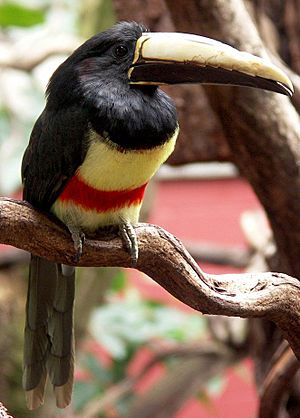Black-necked aracari facts for kids
The black-necked aracari (Pteroglossus aracari) is a colorful bird from the toucan family. You can find it in countries like Brazil, French Guiana, Guyana, Suriname, and Venezuela. It's known for its bright colors and unique bill.
Quick facts for kids Black-necked aracari |
|
|---|---|
 |
|
| Conservation status | |
| Scientific classification | |
| Genus: |
Pteroglossus
|
| Species: |
aracari
|
| Subspecies | |
|
See text |
|
 |
|
| Synonyms | |
|
|
Contents
About the Black-necked Aracari
What's in a Name?
The black-necked aracari was first officially described by a Swedish scientist named Carl Linnaeus in 1758. He gave it the scientific name Ramphastos aracari. Later, it was moved to a different group, or genus, called Pteroglossus.
The name Pteroglossus comes from ancient Greek words. Pteron means "feather" and glōssa means "tongue." The word aracari comes from the Tupi language, which is spoken by some native people in Brazil.
Different Types of Aracaris
Scientists recognize three main types, or subspecies, of the black-necked aracari:
- P. a. atricollis
- P. a. aracari (this is the main type)
- P. a. wiedii
These different types look a bit similar but have small differences in their colors or bill markings.
What Does It Look Like?
The black-necked aracari is about 43 to 46 centimeters (17 to 18 inches) long. It weighs between 177 and 325 grams (6.2 to 11.5 ounces). Both male and female aracaris have similar bright colors. However, the female's bill is usually a bit shorter.
Colors and Markings
Adult black-necked aracaris have a black head, neck, and throat. Their eyes are brown, surrounded by blue-gray or black skin. Their upper body is mostly green, with a bright red patch on their lower back. Their belly is yellow with a wide red band across the lower chest. Their thighs are greenish.
Their bill is very interesting! The upper part (called the maxilla) is ivory-colored. It has a black line on top and a black base. The lower part (called the mandible) is black. There's also a thin white line at the very bottom of the bill.
Young Aracaris
Young aracaris have duller colors. Their black and green feathers look a bit smoky. The red and yellow parts are paler. Their bill is browner and doesn't have the white line at the base like adults.
Subspecies Differences
The P. a. atricollis subspecies has a wider brown stripe on its bill. It also has reddish-brown feathers near its ears and cinnamon-rusty thighs. The P. a. wiedii subspecies has a slightly wider bill stripe than the main type. It also has chestnut-colored feathers on its ears, chin, and upper throat instead of black.
Where Do They Live?
The black-necked aracari lives in different parts of South America.
- P. a. atricollis is found in eastern Venezuela, the Guianas, and northern Brazil.
- P. a. aracari lives in three separate areas of Brazil.
- P. a. wiedii is found in southeastern Brazil.
These birds like to live in many kinds of open areas. This includes the edges of wet forests, clearings, and even fruit tree farms. They usually live from sea level up to about 600 meters (2,000 feet) high.
How Do They Behave?
Staying Put
Black-necked aracaris are believed to stay in the same area all year round. They don't usually migrate to other places.
What Do They Eat?
These aracaris usually look for food in the upper parts of the forest and in the treetops. They often forage in groups of up to six birds, which might be a family. Their main food is fruit, and they are very important for spreading fruit tree seeds. They also eat insects and have even been seen eating baby birds from nests.
Family Life
The breeding season for the black-necked aracari is usually from November to August. In the southern parts of their range, it's from September to February. They make their nests in hollows inside trees. These hollows are often made by woodpeckers or from broken tree branches.
A female aracari usually lays two to four eggs. The parents take turns sitting on the eggs for about 16 to 17 days. After the chicks hatch, they stay in the nest for about 23 days before they are ready to fly. Both parents help to incubate the eggs and care for their young.
What Do They Sound Like?
A common call of the black-necked aracari sounds like "'tsee-eet' to 'sneet'". Sometimes it's longer, like 'tseeeeeee-it'. They also make a "rattled 'bdd-dddit'" sound. This sound might be made with their voice or by rattling their bill.
How Are They Doing?
The IUCN (International Union for Conservation of Nature) has listed the black-necked aracari as a species of "Least Concern." This means they are not currently in danger of disappearing. They live across a very large area. However, their total population size isn't fully known, and it's thought to be decreasing.
Even though they are hunted in some places, they are quite common in many areas. They also live in several protected areas, which helps keep them safe.
See also
 In Spanish: Arasarí cuellinegro para niños
In Spanish: Arasarí cuellinegro para niños


